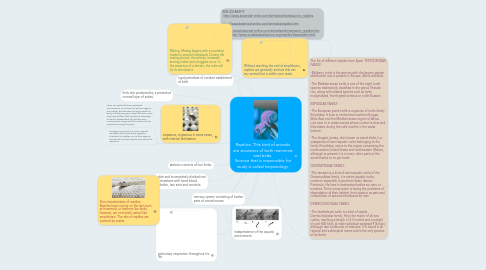Reptiles. This kind of animals are ancestors of both mammals and birds. Science that is responsible for study is called herpetology.
by claudia cobera

1. BIBLIOGRAPHY http://www.botanical-online.com/animales/reproduccion_reptiles. http://www.botanical-online.com/animales/reptiles.htm http://www.botanical-online.com/animales/alimentacion_reptiles.htm http://www.vertebradosibericos.org/reptiles/listareptiles.html
2. thick skin protected by a protective corneal layer of scales.
3. oviparous, viviparous in some cases, with internal fertilization.
3.1. There are reptiles that are considered ovoviviparous, ie not come to lay their eggs on the outside, females retain the eggs inside her body until the young are ready to be born, once they have left their fetal membrane, they begin to lead an independent life; but they are a minority when compared to the amount of real oviparous forming this group.
3.2. The eggs are amniotic, ie, have a specific membrane that prevents the egg dries. Therefore, the reptiles can lay their eggs on land and do not need aquatic environment to reproduce.
4. pulmonary respiration throughout his life.
5. double and incompletely divided into two chambers with heart blood circulation, two atria and ventricle.
6. skeleton consists of four limbs.
7. nervous system consisting of twelve pairs of cranial nerves.
8. rigid patronbes of conduct established at birth.
9. independence of the aquatic environment.
10. Mating: Mating begins with a courtship made by several individuals. During the mating period, the activity increases among males and struggles occur. In the presence of a female, the male will try to stimulate it.
11. Skin characteristics of reptiles. Reptiles have no hair on the skin such as mammals, or feathers like birds, however, are not totally naked like amphibians. The skin of reptiles are covered by scales.
12. Without reaching the end of amphibians, reptiles are generally animals that eat any animal that is within your reach.
13. The list of different reptiles from Spain TESTUDINIDAE FAMILY: -Mulberry turtle is the species with the largest gender distribution and is present in Europe, Africa and Asia. -The Mediterranean turtle is one of the eight turtle species traditionally classified in the genus Testudo too, along with related species such as turtle marginalized, the thighed tortoise or turtle Russian EMYDIDAE FAMILY: -The European pond turtle is a species of turtle family Emydidae. It lives in central and southern Europe, West Asia and the Mediterranean region of Africa. Live near or in watercourses whose current is slow and hibernates during the cold months in the water bottom. -The elegant jicotea, also known as eared slider, is a subspecies of semi-aquatic turtle belonging to the family Emydidae, native to the region comprising the southeastern United States and northeastern Mexico, although at present it is in many other parts of the world thanks to its pet trade. GEOEMYDIDAE FAMILY: -The terrapin is a kind of semi-aquatic turtle of the Geoemydidae family, it is native aquatic turtle, common especially in southern Spain Iberian Peninsula. He lives in freshwater bodies as rivers or marshes. Their conservation is facing the problems of degradation of their habitat, their capture as pets and competition of species introduced by man DERMOCHELYIDAE FAMILY: -The leatherback turtle is a kind of reptile Dermochelyidae family. He is the mayor of all sea turtles, reaching a length of 2.3 meters and a weight of over 600 kilos. A male individual weighed 916 kilos, although rare turtles son of esta size. It is found in all tropical and subtropical mares and is the only species of its family


